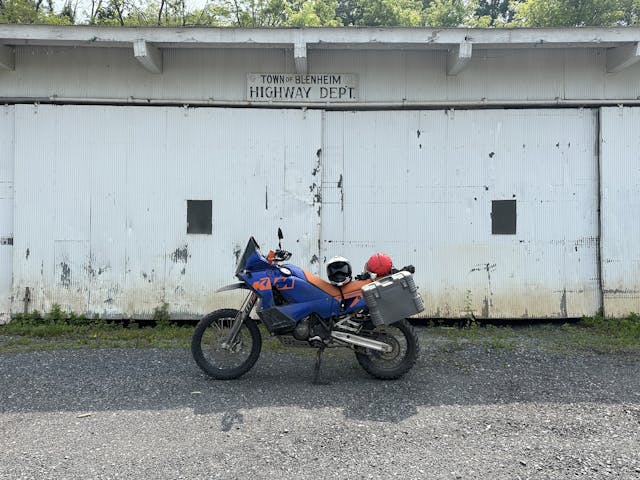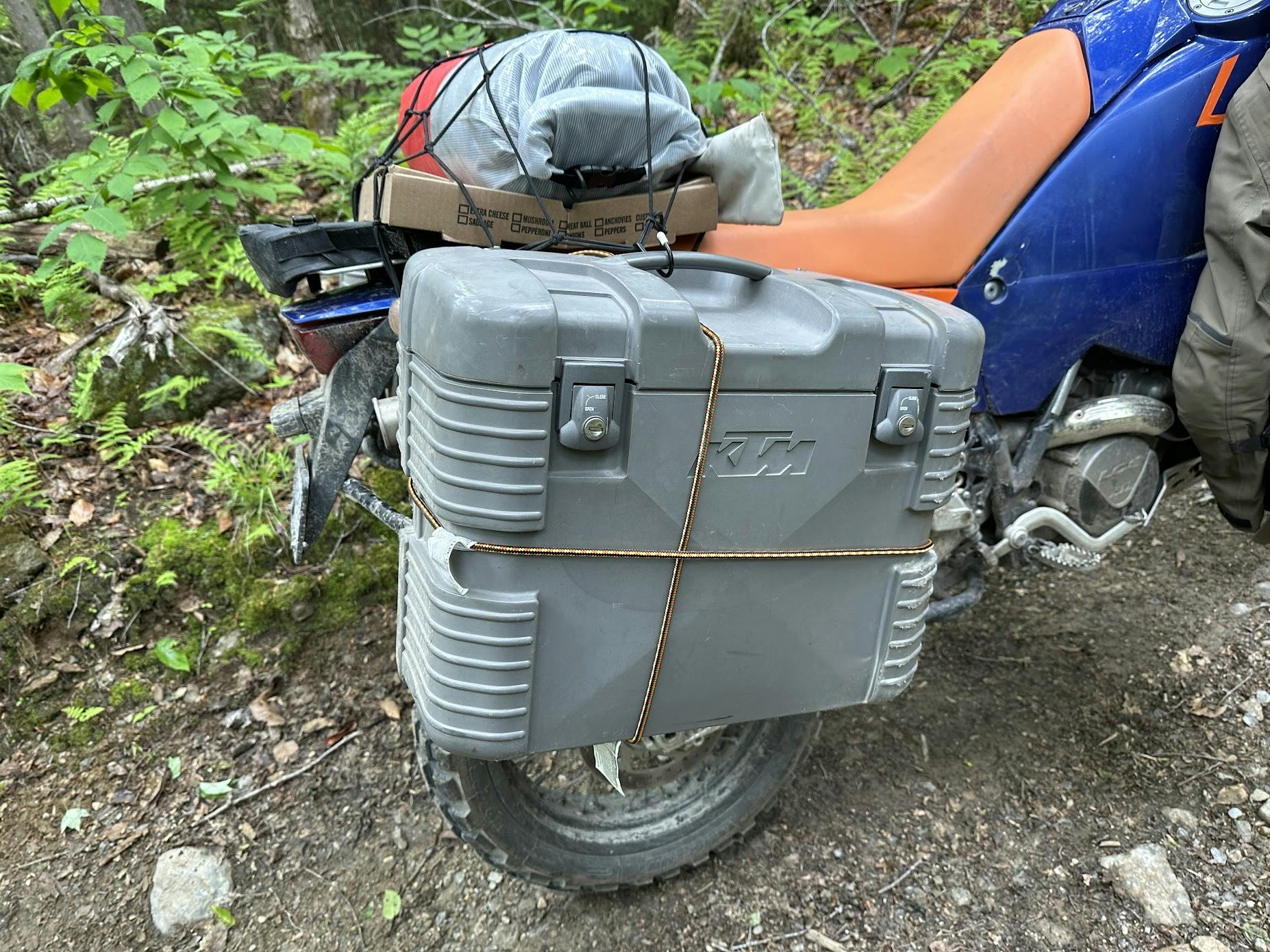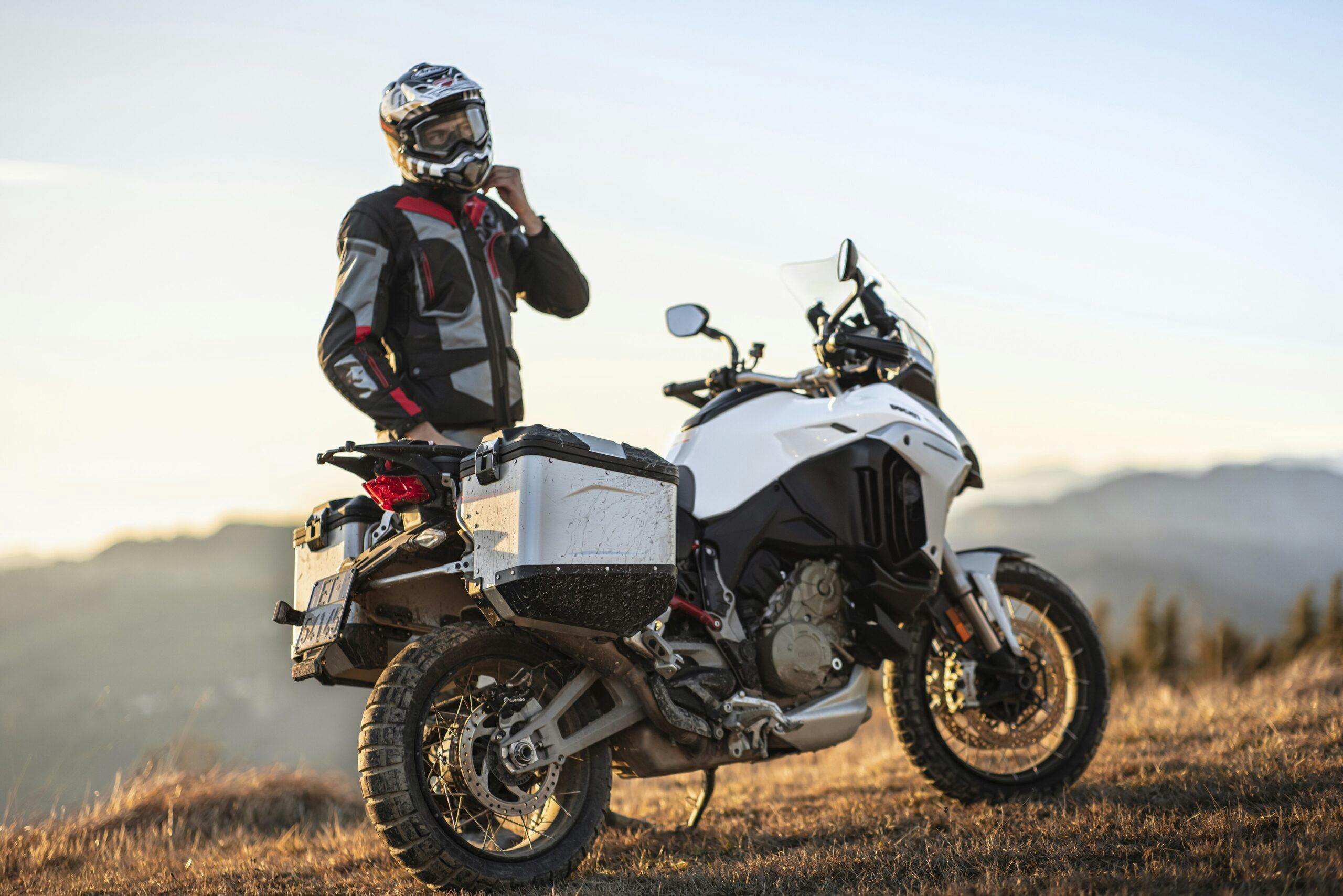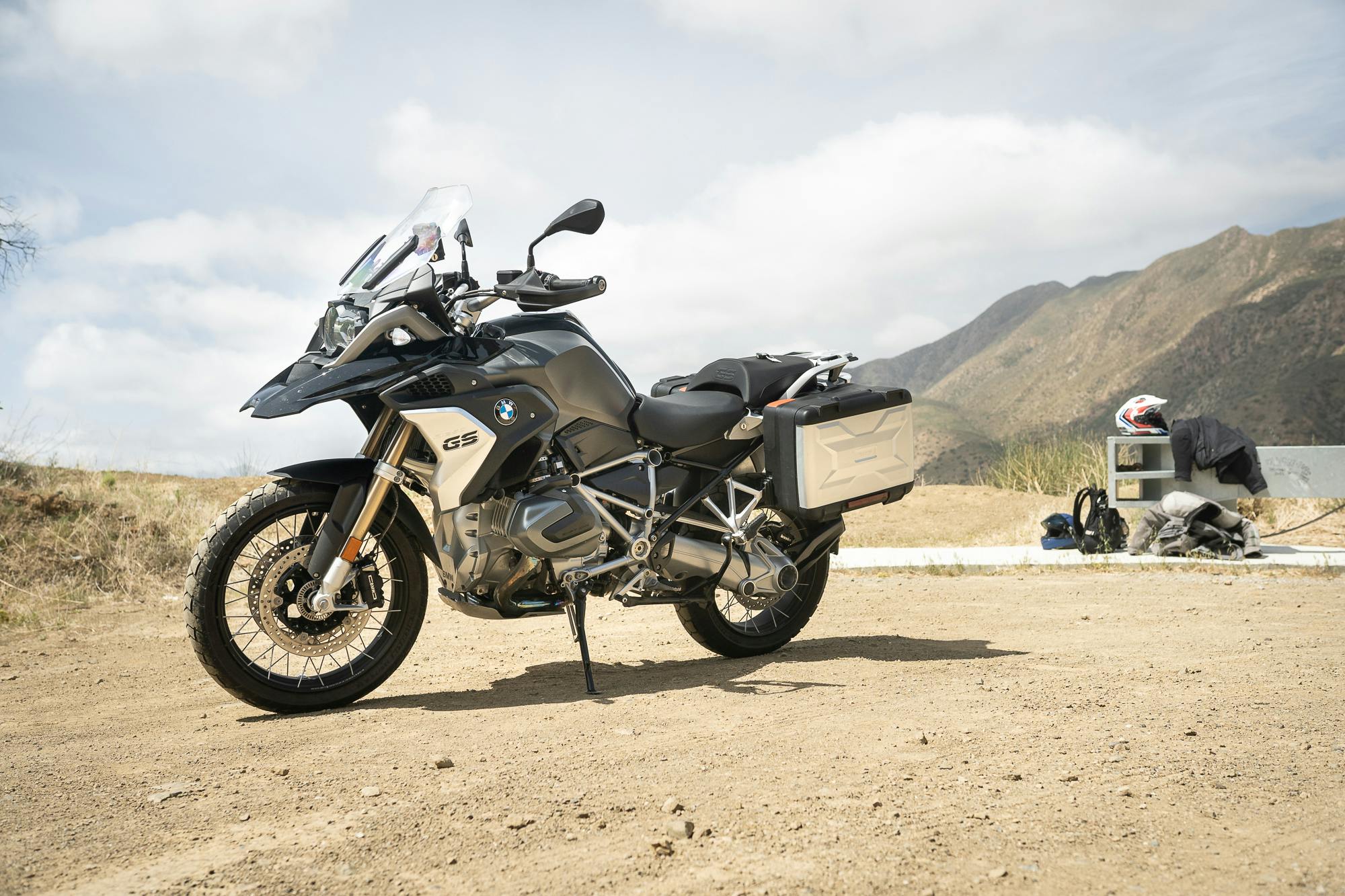I found my one-bike solution, and it isn’t enough
The dirt trail looked like a yard sale. My shave kit perched on a tree root. A jacket was tossed on the ground, along with a bag of tent stakes and the clear shield for a motorcycle helmet. The situation would have been funny if one of the hard cases (formerly) attached to my motorcycle weren’t also sitting in the middle of the trail like some grand prize for a bargain hunter. The latch holding the case to the frame was broken, but I was okay and so was the bike. A few bungee cords fixed everything up quickly, and we were off again.
Two days into a week-long, mostly off-road journey to get a 2005 KTM 950 Adventure S home to Michigan from Essex, Massachusetts, and it still took conscious thought for me to remember those bags were back there. Kind of important, when those cases hold all your belongings, and you and a friend are traversing the North East Back Country Discovery Route, a literal crash course in how to ride a big adventure bike. Luckily, the bike was making me look good. Big WP suspension soaked up everything I pointed the blue and orange beast at. All the long hill climbs of doll head-sized rocks were a game of relaxing and letting the bike do its thing. Keep the revs up and look where you want to go, and the bike would damn near figure the rest out.
If I sound particularly fawn-y over this new bike, it’s because I’m genuinely impressed. I’ve tried multiple times to buy or build the “one motorcycle solution,” and guess what? Honda XR650Rs are terrible on the highway. That poor brown Goldwing really hated gravel roads. The Husky TE510 with motard wheels was close, but damn was the maintenance schedule scary. For a guy who can’t fathom neglecting an engine, that high-strung single-cylinder stuff is mentally exhausting. What’s that ticking noise? Why did it go away? Is it back?
This big KTM just … works. Sure, there are reminders that you are not on a 450 rally bike despite the fact this turns in like one. The V-twin is rev-happy and playful once up over around 4500 rpm. Riding over fast, flowy gravel is a delight with proper body position. Get up and attack, and you can throw nice, manageable power slides at will, all with a thundering boom from the twin Akra cannons mounted under the seat.

This motorcycle reminds me that trucks are the vehicles that killed the sedan. Modern pickups are basically no-compromise vehicles that do everything well. I’ve ridden over 2000 dirt miles on my KTM 950 Adventure S in the first month of ownership and another 1000 or so running around town and making excuses to ride two counties over for lunch.
Those 1000 street miles were racked up just by bobbing around town. Commuting to coffee shops, riding over to a friend’s place for a bourbon, sitting in traffic during the National Cherry Festival in its yearly descent on Traverse City. Never did I want for another motorcycle, though half the time I was leaving some of the KTM’s capability on the table. My enjoyment of this do-it-all motorcycle is just one example of what I think to be a larger trend.
The motorcycle market is narrowing. Yamaha discontinuing the R6. The 250s that were once standard entry bikes have now ballooned to 400cc. Adventure bikes sell on appearance and functionality. KTM alone has four different displacement ADV machines, from 390 to 1290cc. Yamaha offers only three supersport models but already two adventure machines. Honda comes in at three supersports and four ADV bikes. Sound familiar? Like when Ford axed all its cars except the Mustang and stuffed its lineup full of trucks and SUVs?
ADV bikes have become the trucks of the motorcycle world. The BMW G 310 GS is the Toyota Tacoma. BMW R1250GS is the Ford F250 Super Duty Platinum. KTM 1290 Adventure R is Bronco Raptor.
Drivers no longer have to compromise. Fuel mileage with an SUV or truck is a bit down compared to a sedan, but the raised seating position makes for easier entry and exit, plus a better field of view. Toss in hauling and towing capability with a dash of off-road competence, and it’s hard to argue that a modern truck is not the best solution to, “What vehicle should I buy?” We are used to having the option to do anything all of the time, and it’s hard to consider sacrificing one of those options.
The luxury motorcycle brands are in on it, too. The top-selling Ducati for the last two quarters has been the Multistrada. Sounds a lot like Porsche and the Cayenne just a few years back. The GS line brought much-needed life to an ailing BMW back in the 1980s and has been Motorrad’s staple since. Just as the 911 GT3 RS exists thanks to the Cayenne, the M1000RR gets to live because of the R1250GS.
Will the rise of the generalist motorcycle lead to the death of the specialists? I doubt it. History has proven that the one thing that promises to solve all your problems can’t even solve most of them; it merely makes you feel as though it can. My newly acquired KTM has blown me away with the breadth of its capability—I could see myself doing a track day on it just for laughs—but it’s not my track bike. My non-street-legal XR250R, for instance, is so much better in the sandy Michigan singletrack than the KTM that it’s worth the hassle of transporting the Honda to the trailhead.
This is just my personal experience, but it reflects a trend in the market. In 1921, Ford had 61% market share with the Model T, the original do-it-all vehicle. If you consider the selections in the new-vehicle market as a balloon, in 1921 the balloon was probably as contracted as it will ever be. Over time the market swelled with specialized machines—trucks, roadsters, station wagons, limousines. Today, we’re in another contraction: Dealer lots are filled with so many versions of the same, multi-function SUV. It is only time before buyers—even those who don’t consider themselves enthusiasts—beg for specialized vehicles. Hardcore enthusiasts are only the first, and loudest, to protest the narrowing range of selections.
We evolve just like the companies who produce—or used to produce—the machines we enjoy. Today’s generalist machines enable us to find our specific interests by purchasing just one machine. No longer must you dedicate yourself to a single activity only to find that you don’t like it, sell everything to explore another discipline, and repeat the process. Buyers might be hot on generalist machines right now, but that creates a vacuum in the market. Specialist vehicles will return—likely, stronger and better than ever. And, if my KTM is any indication, Swiss Army Knife vehicles don’t have to leave; the best ones are too much fun.

***
Check out the Hagerty Media homepage so you don’t miss a single story, or better yet, bookmark it. To get our best stories delivered right to your inbox, subscribe to our newsletters.









Some interesting statements in this article to think about. I’ll limit my comment to the one truck line as I see this already being a longer post:
I will agree that trucks killed the sedan (2010s F150 is the 1970s Impala) but I think the downsizing and cheapening of sedans, the perception that AWD/4×4 is needed (and traditional domestic sedans seldom getting those options) along with the “this is what is cool” are big factors in that.
I love pick up trucks, but I don’t see them as do-it-all well for all. Yes the top-spec ones of the last 15 years do fill the luxury barge niche well. We are (ironically) looking at a crew cab tomorrow at our favorite dealership to meet the family-hauler needs and they can do that nearly all my wife’s friends drive crew cabs now that they have kids.
Groceries are a challenge as I don’t see “in the bed” as a great option unless you go tonneau cover (they can be great, never had one before my 2014 F150 short box reg. cab), bed divider (my 2010 F150 long box reg. cab had a slot in the bed liner for a 2×8 –brilliant!), and maybe even bed mat or rug. That’s assuming the height of modern trucks doesn’t make putting groceries (or kids) in and out tricky.
My 91 C10 reg. cab long box that I just sold was great at being a truck that hauled lumber. Loved the ride height. Love the hand crank windows (my 2014 had them too!) but lack of AC made it uncomfortable at times and in my jurisdiction it was debatable if I could legally move more than 1 of my children in it at a time due to booster/carseat rules.
For us, we have too many kids for a truck to be true multifunction (well unless the kids stay home). A crew cab and 1 kid means lots of cab space (maybe even all the groceries). But if you do real truck work the 5.5′ bed is limiting.
I think most people that have modern trucks have way more truck than they really need for 95-100% of what they do with a vehicle. The Honda Ridgeline is the postcard of well-engineered compromise but barely moves the sales needle. Test drove a new 2019 expecting lameness and was totally impressed (except by the high price).
I will also admit to having a 93 4×4 and 69 camper truck projects on the backburner at the moment. So I am biased in favor of trucks. Just not convinced so many people should be commuting in them.
You are almost right on the Honda, but let me throw a few extra bits of info at you:
1) The Honda has been outselling several other Mid-Sized trucks since Q2 or Q3 last year, and is the only Mid-Sized truck whose sales numbers are up year over year (the only other less-than-half ton trucks whose YoY numbers are up are the Maverick and Santa Cruz, interestingly), and has outsold the Ranger and Gladiator and Canyon (and a couple of half tons as well) handily. Looking at the YTD Mid-Sized sales through June 2023 (some mfgs only report quarterly so I don’t have full values through July), The Tacoma is #1 at 116.8k units, 2nd place (a distant one) is the Frontier at 34.1k, 3rd is the Colorado at 33.1k, and 4th is the Honda at 27.4k (btw if you include the Maverick, it is at #2 with 42.5k, but it is smaller than Mid-Size so I exclude here), and the rest drop from there. The point being, if you do sales as a % of total Mid-Sized sales, the Honda sells as well as or better than everything but the Tacoma (which is >40% of the market by itself), as the 6.7k YTD sales difference between the Honda and the 2nd place Frontier is a single percentage point difference in market share. This has been the trend since Q2-Q3 2022 FYI. This is also considering the Ridgeline has had nothing changed since 2017, but for a mild facelift in 2021, and the Frontier only jumped to its current place from LAST PLACE after it had its recent redesign. So “barely moves the needle” is a perception, not a reality. It was true on the original 2004-2014 models, but not the 2017+, especially after the 2021 facelift.
2) Similarly, the cost of Honda is not actually out of line for how it is equipped. I challenge you to go to the configuration site of Ford or Chevy, for example, and option their mid-size to have the same (or even slightly less) features to the Honda’s base trim (so crew cab, 4×4 as all Honda’s are AWD so a 4×2 is not a fair comparison, short bed with bed liner, multi zone climate control, power mirrors, towing package to get over the 3500lb base towing and actually beat the Honda’s standard 5000lbs, so on and so forth) and you will find that (using the Ranger as an example) the equivalent truck from them costs over $40k to get MOST but not all of the features available to the “base” model Honda for $38k (and top trim Honda to similarly equipped competitor is actually significantly cheaper). The fact is the Honda is reasonably priced for its features, and does (as you do point out) meet the needs of many truck owners actual use cases (not the image they want to project).
I used to sneer at the Honda myself, and drove half tons, until my cousin got a Honda in 2017 and pointed out that nothing I did in my trucks actually exceeded the capabilities of the Honda. I put my ego aside, tried his out, and I am now on my second one and eagerly await the upcoming Trailsport model for 2024 to replace my 2021 Sport.
This 500 word essay could be summed up in a few words:
Honda’s .9% financing and rebates
I don’t think the Model T had such a high market share because it was “a do-it-all vehicle”, per se. Most of the other cars in that time were designed much the same. The Ford had such a high percentage of sales because Henry’s novel manufacturing process made them cheaper and more plentiful than most of the others. In other words, although it was certainly a great car, if you went car shopping and looked at five vehicles to buy, four of them were Model Ts.
But few other cars of that era had farm implements and snowmobile kits produced specifically for them like the ‘T did. Henry made it pretty clear that his goal was for the ‘T to be the first, last, and only car that a buyer would need. He also made the car affordable, yes, but the ‘T was not the only affordable car. Just the one that sold the best.
Possibly a chicken and the egg scenario in this one. Was it popular for many uses because it was cheap, or was it popular for many uses because there wasn’t anything like it?
Remember that Ford raised wages while lowering prices on the cars. Competing in the low-end mass market was the kiss of death for many.
The doodelbug tractor conversion (sold in Canada by Otaco under license from the American inventor that I forget the name of) worked on whatever you wanted to cut up… model T was just an easy fit, and cheap to find.
The model T and A compressor conversions to my understanding came later and were more specific but that was the converter recognizing the cheap supply of raw materials. 20s & 30s were wild times, there are documented Dusenberg tow truck conversions iirc. If it wasn’t new and valued as pricey any more people found a use for it, like the Harley Davidson engines becoming farm pumps.
For most of my life I’ve had two vehicles, a motorcycle and a VW bus. Since I like to go fast and I’m too old to go fast on a bike I now have a Porsche 911… and a VW bus – a Syncro Westie. All bases covered. 😉
Who needs a sports car when an Escalade…. don’t care. It may be quick but it is no handler compared to say the Blackwing sedans, the Corvette, the Camaro, etc. and that is just sticking with GM. I’m sure the Escalade is a riot in a straight line but it’s handling or looks can be improved upon by going away from the giant land barge configuration.
So we agree. Love to hear it.
Where to begin? My dad was a engineer and taught me that all engineering was a compromise. Want it strong but light? That will mean expensive materials. Want it cheap too? Where will you compromise on the strength or the weight? I carry a Swiss Army Knife but don’t expect it to take the place of my toolbox. Drive an Escalade and a Miata and tell me you can’t tell the difference. They have been trying to make flying cars for a long time now and have discovered that what makes a good airplane makes a lousy car; the inverse is true as well. A do-it-all compromise does everything OK and nothing partcularly well. Folks will get bored of SUVs, which sell more on image than on practicality. I predict that they are a fad that will fade.
“Folks will get bored of SUVs, which sell more on image than on practicality. I predict that they are a fad that will fade.”
Thanks for restating his point I guess? Did you even read the whole article?
“Folks will get bored of SUVs, which sell more on image than on practicality.”
You honestly believe that SUVs/crossovers aren’t practical?
The aging demographic, that had a hard(er) time crawling down into cars that got started, now it’s millenials who take advantage of SUV and cross over’s hauling capabilities.
And you think they’ll ditch them to go from 100-120 cu ft of cargo area to 10% of that in car trunks…
I guess Kyle has never heard of Triumph.
Triumph motorcycle or cars? I would say I am familiar with both, but have only owned a vehicle from the former.
I have both BMW R1200 GS (adventure) and RT (touring) bikes. I’m presently one week into a mega-trip from Calgary to Newfoundland and back. Before I left, I had debated with myself which bike to take. I decided on the RT. It’s a much more refined ride for a long trip: smoother, quieter; the fairings make it more aerodynamic (= better gas mileage); has a bigger gas tank; has a lower centre of gravity, so handles better at speed (and I can just pick it up if it drops; can’t pick up the GS even though it’s a bit lighter). I’m very tall and because the GS sits higher it is has a slightly better sitting position for me. But on the other hand, I’m getting older (73) and it’s now getting difficult to get my leg over the seat to dismount at the end of a long day! The RT is better in that respect. Both bikes are equally adept on dirt roads and packed gravel, although the GS with proper tires is manageable in loose gravel, -the RT is almost impossible to ride in loose gravel. But what really made me decide to leave the GS at home was: I got caught in a monster rainstorm a few weeks ago while riding the GS. Some of the intersections had accumulated several inches of water. Every time I went through one of those puddles -at low speed- I got splashed with water up to my knees, even though I have an extension on the front wheel fender. I thought “that’s not good”. On the RT the fairing prevents that. So in the end I decided to go with the RT. (The RT also has built-in satellite radio which I can listen to with my Bluetooth helmet!) Yet the GS was outstanding on a rugged 2 week trip through Montana & Wyoming last year. It’s more maneuverable at low speed. I guess what I’m saying is I don’t agree with the generalist one bike solution unless one is willing to make compromises (or if you only have room in your garage for one bike of course).
I had once christened the KTM990 as the best bike in the world for the same reasons as you have discovered. IF I could only own one bike, it would be it.
I’ll throw in another element… what you can accomplish with a single under the seat toolkit is spectacular. This bike was meant to be self supporting and has proven as such for myself. The days of actually considering ease of repair and an actual toolkit has long since disappeared in the 4 wheel arena.
If you can learn to master the tire iron, your bike will never need to see the inside of a dealer/shop.
Is there a four wheeled equivalent to my trusty KTM mule? My vote would be my long gone 80’s Toyota Celica hatchback with roof rack. The things I did with that car….
NOPE. Too big. Too heavy. Too high center of gravity.